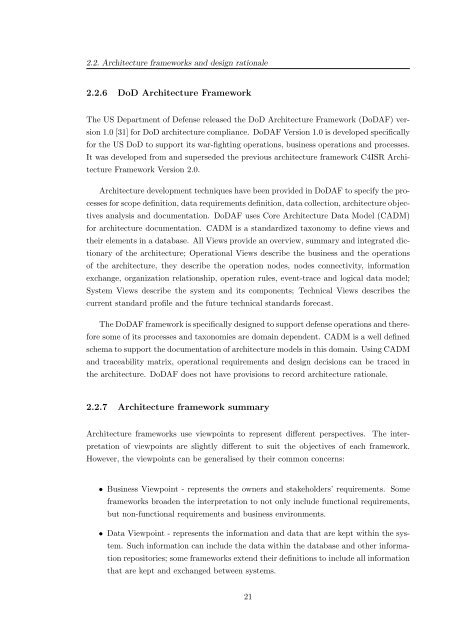A Rationale-based Model for Architecture Design Reasoning
A Rationale-based Model for Architecture Design Reasoning
A Rationale-based Model for Architecture Design Reasoning
You also want an ePaper? Increase the reach of your titles
YUMPU automatically turns print PDFs into web optimized ePapers that Google loves.
2.2. <strong>Architecture</strong> frameworks and design rationale<br />
2.2.6 DoD <strong>Architecture</strong> Framework<br />
The US Department of Defense released the DoD <strong>Architecture</strong> Framework (DoDAF) version<br />
1.0 [31] <strong>for</strong> DoD architecture compliance. DoDAF Version 1.0 is developed specifically<br />
<strong>for</strong> the US DoD to support its war-fighting operations, business operations and processes.<br />
It was developed from and superseded the previous architecture framework C4ISR <strong>Architecture</strong><br />
Framework Version 2.0.<br />
<strong>Architecture</strong> development techniques have been provided in DoDAF to specify the processes<br />
<strong>for</strong> scope definition, data requirements definition, data collection, architecture objectives<br />
analysis and documentation. DoDAF uses Core <strong>Architecture</strong> Data <strong>Model</strong> (CADM)<br />
<strong>for</strong> architecture documentation. CADM is a standardized taxonomy to define views and<br />
their elements in a database. All Views provide an overview, summary and integrated dictionary<br />
of the architecture; Operational Views describe the business and the operations<br />
of the architecture, they describe the operation nodes, nodes connectivity, in<strong>for</strong>mation<br />
exchange, organization relationship, operation rules, event-trace and logical data model;<br />
System Views describe the system and its components; Technical Views describes the<br />
current standard profile and the future technical standards <strong>for</strong>ecast.<br />
The DoDAF framework is specifically designed to support defense operations and there<strong>for</strong>e<br />
some of its processes and taxonomies are domain dependent. CADM is a well defined<br />
schema to support the documentation of architecture models in this domain. Using CADM<br />
and traceability matrix, operational requirements and design decisions can be traced in<br />
the architecture. DoDAF does not have provisions to record architecture rationale.<br />
2.2.7 <strong>Architecture</strong> framework summary<br />
<strong>Architecture</strong> frameworks use viewpoints to represent different perspectives. The interpretation<br />
of viewpoints are slightly different to suit the objectives of each framework.<br />
However, the viewpoints can be generalised by their common concerns:<br />
• Business Viewpoint - represents the owners and stakeholders’ requirements. Some<br />
frameworks broaden the interpretation to not only include functional requirements,<br />
but non-functional requirements and business environments.<br />
• Data Viewpoint - represents the in<strong>for</strong>mation and data that are kept within the system.<br />
Such in<strong>for</strong>mation can include the data within the database and other in<strong>for</strong>mation<br />
repositories; some frameworks extend their definitions to include all in<strong>for</strong>mation<br />
that are kept and exchanged between systems.<br />
21
















